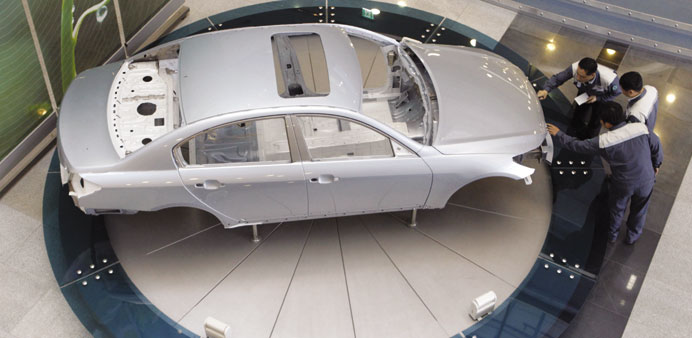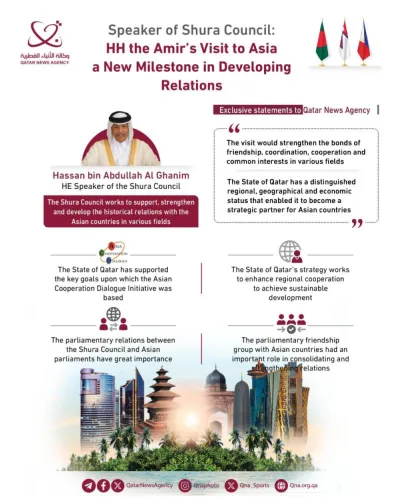Engineers look at a body of Hyundai Genesis displayed at a research and development centre at the company’s steel plant in Dangjin, Seoul. About four years ago, Hyundai considered shifting from steel to aluminium body parts for its Genesis sedan to make it lighter, more fuel-efficient and more competitive with German luxury marques.
About four years ago, Hyundai Motor considered shifting from steel to aluminium body parts for its Genesis sedan to make it lighter, more fuel-efficient and more competitive with German luxury marques, two people familiar with the matter said.
Its affiliate Kia Motors made a similar move, building test versions of its premium K9 sedan, called K900 in the US, using aluminium in body panels including the door, hood and trunk lid, two other people told Reuters.
But the South Korean duo, which together rank fifth in global auto sales, opted for steel instead, deterred by the cost and, according to two of those individuals, hamstrung by close ties with sister steelmaker Hyundai Steel Co.
As western carmakers such as Audi AG and Ford Motor Co lead the way in using aluminium, which is lighter but more expensive than steel, their Asian rivals are reluctant to invest in the costly retooling required that would disrupt existing manufacturing processes and supplier relationships. “A really big challenge at the moment for the Asian companies is to find out how they should behave in this context of vehicles coming under more pressure to be lighter,” said Truls Thorstensen, president and CEO of EFS Business Consultancy.
Automakers in Asia often prefer evolutionary upgrades that enable them to use existing plants and make multiple models on the same assembly lines; western rivals tend to make wholesale product changes that require re-engineering of factories. That’s forcing Asian car companies to find other ways to cut weight and emissions as tighter US and European fuel economy and emissions rules drive a push for lighter cars.
“If you are free to do whatever you want, the decision might be easier to go in the direction of aluminium or light weight,” Thorstensen said.
Hyundai declined to comment on what materials it considered in product development. At Kia, a spokesman said the company did not use aluminium body parts in K9 test versions, and declined to comment on whether it considered using the material during the car’s development.
Aluminium demand by Asia’s auto industry is expected to rise 71% by 2016, far below a projected five-fold jump in North America, according to an internal forecast by Atlanta-based Novelis Corp, the biggest maker of flat-rolled aluminium and a unit of India’s Hindalco Industries .
In 2016, Asia will account for less than a tenth of total auto industry aluminium consumption, while North America and Europe will have about 45% each, Novelis predicts. That’s despite expectations that Asia will continue to account for over half of global vehicle output, according to IHS Automotive. European luxury brands such as Volkswagen AG’s Audi and BMW AG are expanding their use of aluminium in high-end, high-margin cars. Ford will begin building its flagship F-150 pickup with an aluminium body later this year, making it the first such mass-market vehicle.
Hyundai, Toyota Motor Corp and other Asian automakers, however, mostly produce mass-market cars on highly efficient assembly lines that are often decades old. They don’t sell luxury cars in high volumes and can’t demand the sorts of prices that Audi and BMW can.
Aluminium can cost some four times more than steel, although aluminium is up to 30% lighter than conventional steel and 15% lighter compared to advanced, high-strength steel, according to consultancy Wood Mackenzie. A switch to aluminium increases not only materials costs but requires heavy investment to overhaul production lines.
“If you start making a completely different architecture for Lexus from Toyota or Infiniti from Nissan, you will get into a cost problem because the numbers sold and the premium price they get is not similar to the Germans,” Thorstensen said. “All manufacturers in Asia face that same problem. They can’t get the premium price so they have to be much more careful.”
The previous version of Hyundai’s Genesis had an aluminium hood, but the company switched to steel for the current model, launched in late 2013, making it heavier and less fuel efficient than its predecessor, two of the people said.
An aluminium car hood weighs about half of one made of steel, according to Novelis. Every 10% reduction in vehicle weight improves fuel economy by 6-8%, according to the US Department of Energy.
In 2010, when Hyundai began developing the current-generation Genesis, shaving weight and increasing fuel economy was a concern, said one of those familiar with the matter.
At a meeting at the automaker’s research centre on the outskirts of Seoul, engineers proposed expanding the use of lightweight aluminium from the hood to other outer body panels and even frames, said the person, who was present. But Hyundai went in the opposition direction, swapping aluminium with steel even for the hood, because of its ties with Hyundai Steel and the higher costs associated with aluminium.
“This was a step backward for Hyundai,” the person said.
The latest Genesis gained as much as 390 pounds (177 kg) from its predecessor, launched in 2008, and weighs 181 pounds more than BMW’s rival 535i.
US chief Dave Zuchowski said Hyundai has “put a lot of additional weight into structural rigidity” to pass tougher US crash tests. “We used to say we’d like to reduce the weight in the car 10% as we bring them out. In this world, with ... crash requirements and things like that, you’re not going to be able to do that,” he told reporters in Detroit last month.
Instead of embracing aluminium, Asian automakers are working with steelmakers to develop lighter, stronger steel, while taking other measures to improve fuel efficiency including upgrading conventional engines and parts without having to make heavy modifications to manufacturing facilities.



